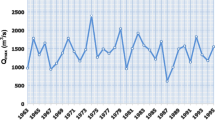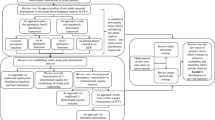Abstract
Multivariate analysis of flood frequency was used extensively in water resources research. Often the only flood peak or volume is analyzed with statistical distributions, but for a perfect and exact result, the four main characteristics of a flood event, as well as peak, volume, duration, and time-to-peak, are needed. For this reason, multivariate statistical approaches like copula functions developed. This research aims to define and use the bivariate copula (2-copula) probability distribution functions (PDF) for flood characteristics multivariate analysis. When the joint distribution of characteristics such as volume and peak is known, it is possible to define the probability of simultaneous occurrence of design volume and peak flow values.




Similar content being viewed by others
References
Akaike H (1974) A new look at the statistical model identification. IEEE Trans Autom Control 19(6):716–723
Archer D (1998) Flood frequency analysis. In: Encyclopedia of Hydrology and Lakes. Encyclopedia of Earth Science. Springer, Dordrecht
Ash RB (2008) Basic probability theory (Dover ed.), Mineola, N.Y.: Dover Publications. pp 66–69
Ayantobo O, Li Y, Song S (2019) Multivariate drought frequency analysis using four-variate symmetric and asymmetric Archimedean copula functions. Water Resour Manag 33:103–127
Box GEP, Cox D (1964) An analysis of transformation (with discussion). J Roy Statist Soc Ser B 26:211–246
Brenchmann EC, Schepsmeier U (2013) Modeling dependence with C- and V-Vine copulas: the R package CDVine. J Statist Soft 52(3):1–27
Burnham KP, Anderson DR (2002) Model selection and multimodel inference: a practical information-theoretic approach (2nd ed.), Springer-Verlag
Chen L, Guo S, Yan B, Liu P, Fang B (2010) A new seasonal design flood method based on bivariate joint distribution of flood magnitude and date of occurrence. Hydrologic Sci 55(8):1264–1280
De Michele C, Salvadori G, Canossi M, Petaccia A, Rosso R (2005) Bivariate statistical approach to check adequacy of dam spillway. J Hydrol Eng 10(1):50–57
Dupuis DJ (2007) Using copulas in hydrology: benefits, cautions, and issues. J Hydrol Eng 12(4):381–393
Evans M, Rosenthal JS (2010) Probability and statistics: the science of uncertainty (2nd ed.), New York: W.H. Freeman and Co
Everitt BE (2006) The Cambridge dictionary of statistics (3rd ed.), Cambridge, UK: Cambridge University Press
Favre A-C, El Adlouni S, Perreault L, Thiémonge N, Bobée B (2004) Multivariate hydrological frequency analysis using copulas. Water Resour Res 40(1):W01101
Ganguli P, Reddy MJ (2013) Probabilistic assessment of flood risks using trivariate copulas. Theoretic Appl Climatol 111:341–360
Genest C, MacKay RJ (1986) Copules archimédiennes et familles de lois bidimensionnelles dont les marges sont données. Canad J Statat 14(2):145–159
Genest C, Favre A-C (2007) Everything you always wanted to know about copula modeling but were afraid to ask. J Hydrol Eng 12(4):347–368
Ghizzoni T, Roth G, Rudari R (2010) Multivariate skew-t approach to the design of accumulation risk scenarios for the flooding hazard. Adv in Water Resour 33:1243–1255
Goda K (2010) Statistical modeling of joint probability distribution using copula: Application to peak and permanent displacement seismic demands. Struc Safet 32:112–123
Grimaldi S, Serinaldi F (2006) Asymmetric copula in multivariate flood frequency analysis. Adv in Water Resour 29(8):1155–1167
Gumbel EJ (1960) Bivariate exponential distributions. J Americ Statist Assoc 55:698–707
Gumbel EJ, Mustafi CK (1967) Some analytical properties of bivariate extreme distributions. J Americ Statist Assoc 62:596–688
Joe H (1997) Multivariate models and dependence concepts. Chapman and Hall, CRC, Boca Raton
Lorenz M, Bliefernicht J, Haese B, Kunstmann H (2018) Copula-based downscaling of daily precipitation fields. Hydrolog Proc 32:3479–3494
McElreath R (2016) Statistical rethinking: a Bayesian course with examples in R and Stan. CRC Press
Nelsen RB (1999) An introduction to copulas. Springer
Nelsen RB (2006) An introduction to copulas. Springer
Palynchuk BA, Guo Y (2011) A probabilistic description of rainstorms incorporating peak intensities. J Hydrology 409:71–80
Park KII (2018) Fundamentals of probability and stochastic processes with applications to communications, Springer
Razmkhah H (2018) Parameter uncertainty propagation in a Rainfall – Runoff model; Case study: Karoon III river basin. Water Resour 45(1):34–49
Razmkhah H, Saghafian B, AkhoundAli AM, Radmanesh F (2016a) Rainfall-Runoff modeling considering soil moisture accounting algorithm, case study: Karoon III river basin. Wat Resource 43(4):699–710
Razmkhah H, AkhoundAli AM, Radmanesh F, Saghafian B (2016b) Evaluation of rainfall spatial correlation effect on rainfall-runoff modeling uncertainty, considering 2-copula. Arab J Geoscience 9:323
Razmkhah H, AkhoundAli AM, Radmanesh F (2017) Correlated parameters uncertainty propagation in a Rainfall-Runoff model, considering 2-copula, case study: Karoon III river basin. Env Model Assess 22:503–521
Reddy MJ, Ganguli P (2012) Bivariate flood frequency analysis of upper Godavari river flow using Archimedean copulas. Water Resour Manag 26(14):3995–4018
Renard B, Lang M (2007) Use of a Gaussian copula for multivariate extreme value analysis: Some case studies in hydrology. Adv Water Resour 30:897–912
Salvadori G, De Michele C (2007) On the use of copulas in hydrology: Theory and practice. J Hydrol Eng 12(4):369–380
Schwarz GE (1978) Estimating the dimension of a model. Ann Stat 6(2):461–464
Serinaldi F, Grimaldi S (2007) Fully nested 3-copula: Procedure and application on hydrological data. J Hydrol Eng 12(4):420–430
Singh VP (1987) Hydrological frequency modeling. Reidal, Boston
Singh K, Singh VP (1991) Derivation of bivariate probability density functions with exponential marginals. Stoch Hydrol Hydraul 5:55–68
Sklar A (1959) Fonctions de repartition an dimensions et leurs marges. Publications De L’institut Statistique De L’universite De Paris 8:229–231
Taddy M (2019) Business data science: Combining machine learning and economics to optimize, automate, and accelerate business decisions. McGraw-Hill, New York
Vittal H, Singh J, Kumar P, Karmakar S (2015) A framework for multivariate data-based at-site flood frequency analysis: Essentiality of the conjugal application of parametric and nonparametric approaches. J Hydrol 525:658–675
Wang C, Chang N-B, Yeh G-T (2009) Copula-based flood frequency (COFF) analysis at the confluences of river systems. Hydrol Process 23(10):1471–1486
Wit E., Heuvel EVD, Romeijin JW (2012) All models are wrong...’: an introduction to model uncertainty. Statistica Neerlandica 66(3):217–236
Yue S (2001) A bivariate gamma distribution for use in multivariate flood frequency analysis. Hydrol Process 15(6):1033–1045
Yue S, Quarda T, Bobee B, Legendre P, Bruneau P (2002) Approach for describing statistical properties of flood hydrograph. J Hydrologic Eng 7(2):147–153
Yue K-X, Xiong L, Gottschalk L (2014) Derivation of low flow distribution functions using copulas. J Hydrology 508:273–288
Zening W, Chentao H, Wang H, Zhang Q (2020) Reservoir inflow synchronization analysis for four reservoirs on a multivariate copula model. Water Resour Manag 34:2753–2770
Zhong M, Zeng T, Jiang T, Wu H, Chen X, Hong Y (2021) A copula-based multivariate probability analysis for flash flood risk under the compound effect of soil moisture and rainfall. Water Resour Manag 35(4):1–16
Author information
Authors and Affiliations
Contributions
Homa Razmkhah: Conceptualization, data curation, methodology, analysis, interpretation of the results, software, visualization, and writing. Alireza Fararouie and Amin Rostami Ravari: Supervised the study and reviewed the whole content. All authors read and approved the manuscript.
Corresponding author
Ethics declarations
Ethics Approval
Not applicable.
Consent to Participate
Authors have agreed to submit the article.
Consent for Publication
Authors have agreed to submit the article in this Journal.
Conflicts of Interest
The authors have no conflict of interest.
Additional information
Publisher's Note
Springer Nature remains neutral with regard to jurisdictional claims in published maps and institutional affiliations.
Rights and permissions
About this article
Cite this article
Razmkhah, H., Fararouie, A. & Ravari, A.R. Multivariate Flood Frequency Analysis Using Bivariate Copula Functions. Water Resour Manage 36, 729–743 (2022). https://doi.org/10.1007/s11269-021-03055-3
Received:
Accepted:
Published:
Issue Date:
DOI: https://doi.org/10.1007/s11269-021-03055-3




